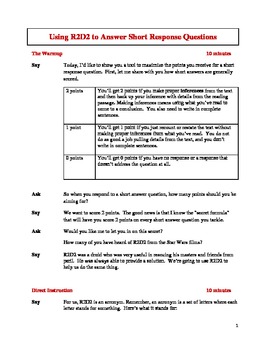Nicole's "Let's Rock the Test"
542 Followers
Grade Levels
8th
Resource Type
Standards
CCSSRI.8.3
CCSSRH.6-8.1
CCSSRH.6-8.2
CCSSRH.6-8.4
CCSSRH.6-8.9
Formats Included
- PDF
Pages
9 pages
Nicole's "Let's Rock the Test"
542 Followers
Description
This package includes detailed instructions for how to use a mnemonic device as a test-taking strategy for writing exemplary short response answers and receiving the maximum amount of points on standardized tests. This package also includes a detailed script with time blocks for teachers to use when teaching and implementing this strategy in their classrooms. Additionally, this package provides two sample passages with questions, answers, and aligned common core standards that would normally be found on a standardized test, for students to practice and retain this new strategy.
If you are looking for more opportunities for your students to practice, check out my product - "The Totally Awesome Test-Prep Strategies Toolkit & Practice Packs." It addition to the articles, it gives great mnemonic devices to help students learn how to confidently attack a test (close-reading, multiple choice, short response and extended response questions plus ways to mentally prepare before and during tests.)
Here’s the links to the Toolkit and Practice Packs
The Totally Awesome Test-Prep Strategies Toolkit & 3rd Grade Practice Pack
The Totally Awesome Test-Prep Strategies Toolkit & 4th Grade Practice Pack
The Totally Awesome Test-Prep Strategies Toolkit & 5th Grade Practice Pack
The Totally Awesome Test-Prep Strategies Toolkit & 6th Grade Practice Pack
The Totally Awesome Test-Prep Strategies Toolkit & 7th Grade Practice Pack
The Totally Awesome Test-Prep Strategies Toolkit & 8th Grade Practice Pack
If you are looking for more opportunities for your students to practice, check out my product - "The Totally Awesome Test-Prep Strategies Toolkit & Practice Packs." It addition to the articles, it gives great mnemonic devices to help students learn how to confidently attack a test (close-reading, multiple choice, short response and extended response questions plus ways to mentally prepare before and during tests.)
Here’s the links to the Toolkit and Practice Packs
The Totally Awesome Test-Prep Strategies Toolkit & 3rd Grade Practice Pack
The Totally Awesome Test-Prep Strategies Toolkit & 4th Grade Practice Pack
The Totally Awesome Test-Prep Strategies Toolkit & 5th Grade Practice Pack
The Totally Awesome Test-Prep Strategies Toolkit & 6th Grade Practice Pack
The Totally Awesome Test-Prep Strategies Toolkit & 7th Grade Practice Pack
The Totally Awesome Test-Prep Strategies Toolkit & 8th Grade Practice Pack
Total Pages
9 pages
Answer Key
Included
Teaching Duration
45 minutes
Report this resource to TPT
Reported resources will be reviewed by our team. Report this resource to let us know if this resource violates TPT’s content guidelines.
Standards
to see state-specific standards (only available in the US).
CCSSRI.8.3
Analyze how a text makes connections among and distinctions between individuals, ideas, or events (e.g., through comparisons, analogies, or categories).
CCSSRH.6-8.1
Cite specific textual evidence to support analysis of primary and secondary sources.
CCSSRH.6-8.2
Determine the central ideas or information of a primary or secondary source; provide an accurate summary of the source distinct from prior knowledge or opinions.
CCSSRH.6-8.4
Determine the meaning of words and phrases as they are used in a text, including vocabulary specific to domains related to history/social studies.
CCSSRH.6-8.9
Analyze the relationship between a primary and secondary source on the same topic.




